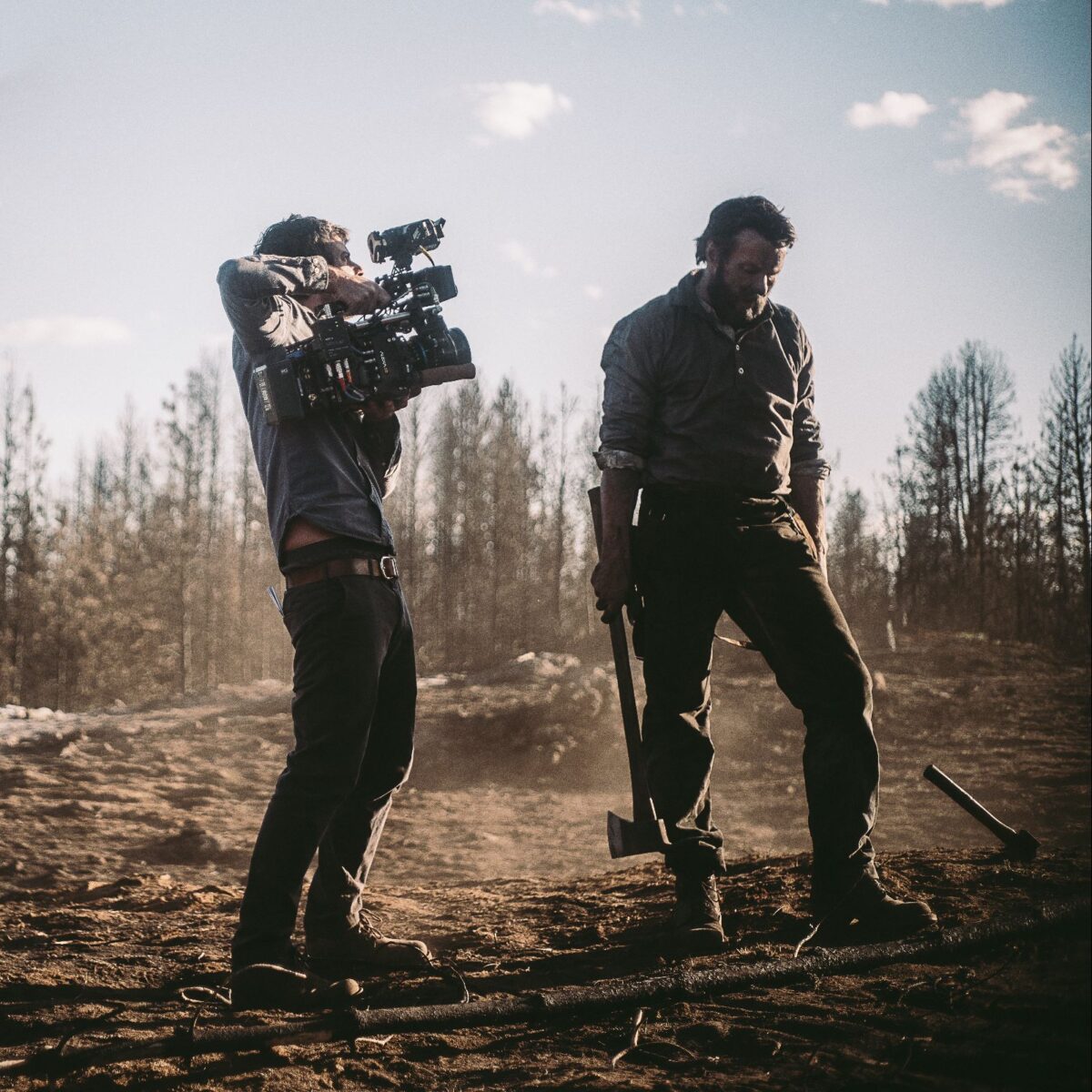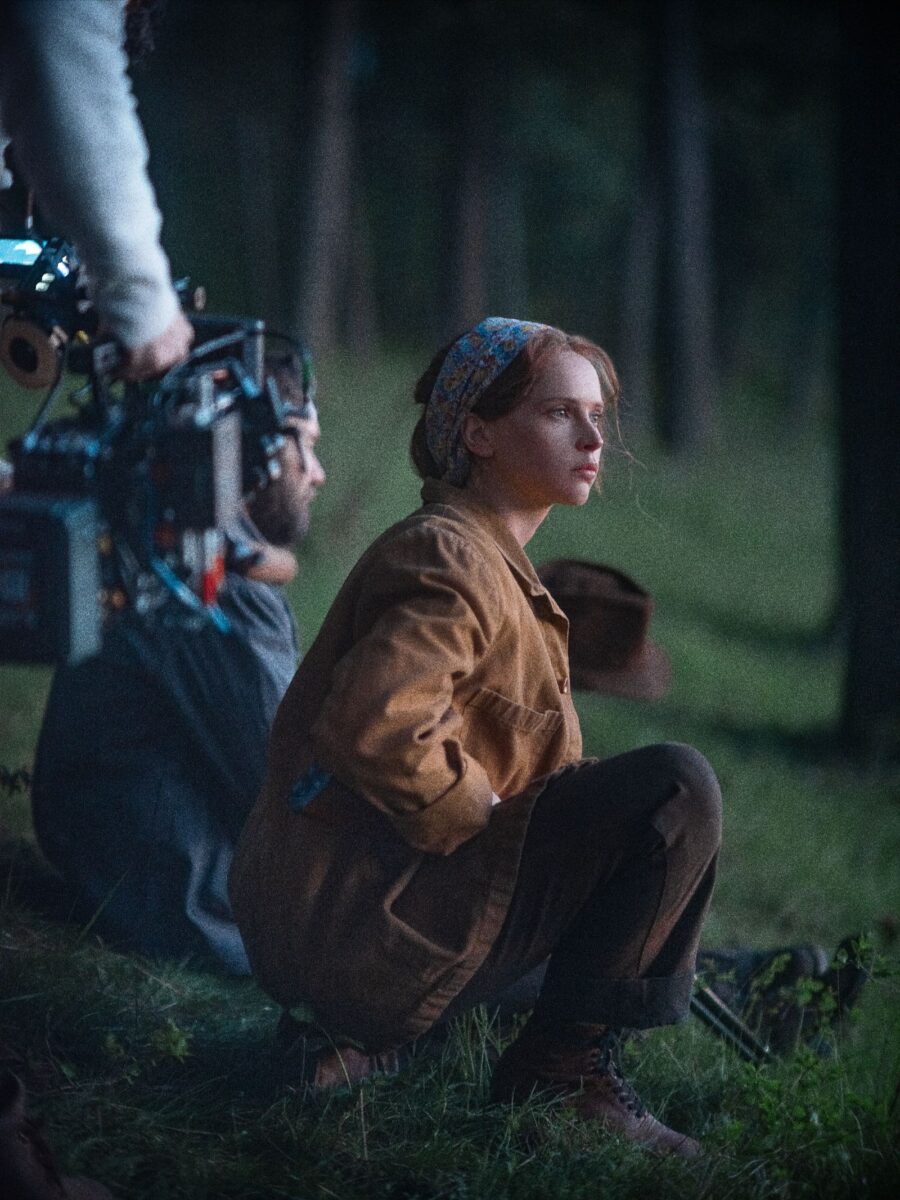
Through the eyes of itinerant logger Robert Granier (Joel Edgerton), Train Dreams traces America’s transition from a pioneer land firmly into an industrialized nation through the first half of the 20th Century. Clint Bentley and Greg Kwedar are longtime writing partners who take turns directing projects: Kwedar directed 2016’s Transpecos and last year’s Sing Sing, and Train Dreams is Bentley’s directorial follow-up to 2021’s Jockey.
An adaptation of a Denis Johnson novella, the period piece was shot on location in the Pacific Northwest, and the narrative encompasses an impressive scope of time, with different men and women coming in and out of Granier’s life who nearly all leave some impression on Granier, often unbeknownst to them. William H. Macy steals scenes as Arn Peeples, a demolition expert who feels their logging of 200-year-old trees leaves a negative impact on one’s soul. Felicity Jones is Granier’s wife Gladys, who longs for Granier whenever he’s away for months during logging season. It’s a Malickian tale invested in Granier’s grappling with the impact one’s own life, lived in one singular moment in time, holds in history.
Ahead of the film’s release on Netflix today, I spoke with Bentley at the London Hotel in West Hollywood, where we discussed why shooting digitally with natural and practical lights was the only option for the indie production, how Granier was inspired by men in Bentley’s life, and how a memorable cowboy sequence was born out of a ticking clock on set that day.
The Film Stage: How research on a project manifests on screen can sometimes be a little abstract. Do you have any tangible examples of how your extensive research led to things onscreen? On the flip side: research can also lead to less tangible insights, though just being in an area and getting a feel for the people there.
Clint Bentley: Research is that great mysterious process, because you never know what’s going to be right around the corner, just going to an area and seeing what’s there. Early in the film, there’s an image of a big, 11-foot sturgeon hanging on a pole. That came directly from being in the panhandle of Idaho with Greg Kwedar, my co-writer. We were driving around and I went to a little museum in Bonners Ferry, and they had all these pictures of these people posing next to these 10- and 11-foot sturgeon they had pulled out of the rivers up there, these prehistoric fish that didn’t exist anymore at that size.
And from a book I learned about guys who used to ride the logs down the rivers and take these long poles and clear up jams. It was an incredibly dangerous job, and whenever one would die they would take their boots and nail them to the tree. That struck me, and ended up becoming a very potent image that defines part of the movie in a way that I didn’t expect. I could go on and on, but research always gives you so much, and more importantly sparks ideas that you might not have had otherwise.
You’ve talked about the reverence you hold for Granier and these men. How do you treat these characters with reverence while still allowing them to be humans? There’s this fine line where you might not want to let anything bad happen to them or let them do anything wrong, because you have so much love for them.
It’s funny. It’s like your children to an extent, where you love them deeply and want to protect them from anything bad happening, but you also know that if nothing bad happens to them, they’ll never grow. It’s the same with characters, where you’ve got to let some things happen to them in the narrative, so that you see how they respond as people to those moments. That’s something that’s ineffable and strange about the screenwriting process, where you find yourself at times being surprised by what they do—as odd as that sounds.
Will Patton’s narration sometimes fills in gaps about Joel’s character Robert, often explaining what he’s thinking or feeling. Was that narration in conversation with how you’re working with Joel?
It was very much in conversation with him. Joel is a rare artist who sees and knows the whole process, and so he knew that was there. The narration was being shaped along the way, until late in the edit, when it was finally locked. We were always trying to find that balance where we would flag moments where I felt like it would be like it was scripted with narration, and where it was like, “Okay, we’re doing this moment as a silent film.”
It was striking to me. A lot of times, if I had to drop out the narration—nine times out of 10—it was still there on the screen. When he’s baiting in this lake after having a big realization in his life, and he’s just looking at his hands—that had narration all over it and was some of my favorite narration in the movie. Yet it felt like something was not getting there with the moment and people weren’t connecting with it. Pulling the narration out and just letting us be with him, seeing what he’s feeling, made that moment so much richer and deeper.

Joel has this unique ability where he’s not playing a dumb character, but he’s not playing an educated man either. He’s this working-class man who wants something deeper out of life, and Joel portrays this subtly in his face or the way he behaves.
That’s part of the character and reminds me of men who’ve raised me through my life. My uncle is somebody who never went to college or anything, and yet is a deep and thoughtful man. Sometimes he will say things that I’m like, “Oh yeah, Kierkegaard said that as well.” He’s saying it in a different language, a different style. Education does not always equal depth. Joel is incredible at that, and that was something we talked about early on: wanting to portray a deep character whose emotions, thoughts, and feelings are very much there running under things. But he doesn’t quite have the vocabulary to get them out. It’s a beautiful quality that Joel can give such a soulful performance with so little.
You’re working with your Jockey cinematographer, Adolpho Veloso. What was your process with him? Did you do camera and lens-testing in the region?
We explored if we could shoot on film. Ultimately we wanted to shoot in such a way that we use natural light as much as possible. Everything, except for two scenes, is lit completely with natural light in the film. When they’re sitting around a fire, it’s lit by a fire. When they’re sitting around candles and lanterns in the cabin, it’s lit by candles and lanterns. This is an independent film with limited resources and time, and shooting on digital on the ALEXA 35 gave us much more bandwidth and much more flexibility in just having more stops of light that we could work with. We tested a lot of lenses, and we had one set of lenses that we used in the daylight: these Kowas that caught flares in a beautiful way. And then these Zeiss Super Speeds at night moved a little faster and were more sensitive to low light conditions.
I imagine shooting on film, as an independent production, if something goes wrong in the middle of the woods, that can really disrupt the production.
Totally. And I advocate shooting on film whenever you can. It offers something hard to manufacture, something organic. And yet, just because of the state of the industry, we were shooting out in Spokane, Washington on the east side of the state, the amount of money even just sending the dailies off to be processed was outside of our budget consideration.
On my second watch, I was struck by the sound design. It shifts throughout the movie: the way the forest sounds in one scene might sound a little different in other parts of the movie. After the fire, it becomes a much quieter movie, especially when Robert’s sitting alone up on that plain. Take me into developing this soundscape—it’s an equally impressive part of the movie alongside the cinematography.
I totally agree, and a lot of that credit goes to Lee Salevan, our sound designer who worked on Jockey as well. We talked about each space having its own personality. He doesn’t work in such a way where we just hand him the film after it’s edited and then he lays on sound design. We’re passing scenes back and forth along the way, and he’s designing soundscapes for the dream sequences that are then influencing how those get edited. It’s a lovely collaboration.
To your point: we talked about making the forest feel alive and rich in the early days before the fire, and having this sense of life and mystery to it, and then let that go away. All life is gone from the forest directly after the fire, and then we slowly build it back, but in a different way across the rest of the film. Some sounds in the early part of the film never come back. Even though it regains life, it regains it in a different way.

How’d you do that visually as well, portraying the journey from the beginning of the film through with Robert?
That was more in sections. When he is living at home with his family, it’s loose and handheld and has this comfortable and beautiful sense of place. When he’s out in the woods with the guys, a lot of that’s on sticks or dollies. It almost feels like you’re looking at a photograph, or a memory of his time back there. As it gets further forward, it was about finding bits of language to show his isolation, even within frames where he’s surrounded by people, framing him off by himself.
The shots of the men in the woods reminded me of portrait photography at the time, in the way they’re posed. Do you have a favorite scene to stage or that you’re particularly proud of?
The one that I just love how it turned out, because it was very different than how I thought it would, was where the cowboy steps into the movie as if he’s from another movie. We had planned to shoot that in six set-ups, and then we just ran out of time that day. We came to the realization, “Okay, we can do those six set-ups, but only one take on each. Or we can find the frame and set it up, and then we can run it about six times.” And we decided to do the latter. I’m really happy with how it turned out.
Watching that cowboy scene again, I’m noticing all of these little details: Paul Schneider’s character is slowly putting up his feet, for instance.
As much as possible, we tried to load the frame with little details and even props. Early on, two-year-old Kate is playing with a toy that’s a horse and a wagon which presages things to come. These little, subtle acts don’t call terrible attention to themselves, but hopefully reward multiple viewings.
My favorite scene is with William H. Macy and Edgerton at night in their tents, when he’s singing the song and playing the harmonica.
I love that scene too, and that’s actually one of my favorite experiences from set. We finished that night. He does it on camera, but the characters tell him, “Shut up. Stop singing.” They cut him off. I was like, “I think we’ll want to play that song over the credits.” It’s so lovely. So we turned the cameras off. We all sat around. Everybody got quiet. We’re out in the woods, and we put a mic in the tent with Bill and let him sing his song and play it. It’s one of my favorite film memories ever.
Train Dreams is in select theaters and available to stream on Netflix.
The post Train Dreams Director Clint Bentley on Natural Light, Shaping Narration, and Real-Life Inspiration first appeared on The Film Stage.
from The Film Stage https://ift.tt/KiocdAJ

0 Comments